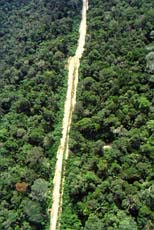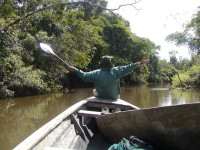
Photo. Acre, where the vanished tribe was found. The Amazon Forest covers 95% of the state of Acre. © Paulo Jares/Abril Imagens.
It was in an area that they believed was an inhabited mountain landscape on the border to Peru. The members of the Naua-tribe came out of the jungle to meet the representatives from the authorities.
The whole of Acre lies in the Amazon Basin. 93% of its territory is covered with tropical rain forest. Acre is divided in two geographical regions, which are the drainage basins of the rivers Juruá and Purús.
Some facts about the state Acre where the unknown tribe was found
- Westernmost Brazilian state
- Neighbouring countries: Peru and Bolivia
- Neighbouring Brazilian states: Amazons and Rondônia
- Population: 438,489 (1996)
- Area: about 55,000 sq. mi
- Capital: Rio Branco with 288,907 inhabitants (1996)
Other exotic tribes in the region
There are still several exotic tribes left in this region. The Indian people of the Amazon Basin are divided into 6 linguistic groups: Tupi, Karib, Tukano, Jê, Pano and Aruaque. Some tribes live isolated without contact. These Indians live from hunting, fishing, agriculture and gathering. They plant manioc, corn, cotton, tobacco and various fruits.
This region is one of the few places in the world where it is still possible to experience authentic tribe cultures. The exploration of the Naua-tribe was a great event for us in other parts of the world, but probably not for them. For people who would like to visit Naua and other tribes in the area, it is of big importance that they respect their culture values. If the tribes loose their culture, they will also loose their identity, and in the long run they will get problems with surviving.
It is so interesting to experience their traditional habits as healing rituals, medicinal herbs, traditional hunting and fishing. Furthermore it is also interesting to listen when they speak own language, and to see their unique handicraft and ceramic work.
Stein Morten Lund, 18 August 2000
Additional information
We in Travel Explorations believe that there are still unexplored tribes in the world. It is most likely that they live in Brazil, especially in some parts of the Amazon region. Explorations started here for many hundred years, but the area is so incredible large that there is so much more to look for.
The delta region of the Amazon may have been discovered by Vicente Yánez Pinzón in 1500, but explorations did not begin until 154-41. An expedition led by Francisco de Orellana started down the Napo River, in what is now Ecuador, and reached the Atlantic Ocean. Pedro Teixeira undertook the first upstream voyage.
Between October 1637 and August 1638 he ascended the Amazon to the source of the Napo River and crossed the Andes to Quito, Ecuador. Later, he returned by the same route. In modern times the river has been explored by many scientific expeditions, including that led (1914) by Theodore Roosevelt and others sponsored by the National Geographic Society and the government of Brazil.













